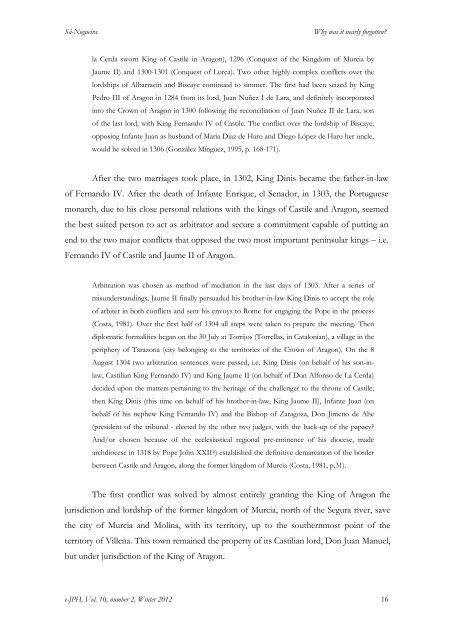Why was it nearly forgotten? The Agreda Treaty ... - Brown University
Why was it nearly forgotten? The Agreda Treaty ... - Brown University
Why was it nearly forgotten? The Agreda Treaty ... - Brown University
You also want an ePaper? Increase the reach of your titles
YUMPU automatically turns print PDFs into web optimized ePapers that Google loves.
Sá-Nogueira<br />
<strong>Why</strong> <strong>was</strong> <strong>it</strong> <strong>nearly</strong> <strong>forgotten</strong>?<br />
la Cerda sworn King of Castile in Aragon), 1296 (Conquest of the Kingdom of Murcia by<br />
Jaume II) and 1300-1301 (Conquest of Lorca). Two other highly complex conflicts over the<br />
lordships of Albarracín and Biscaye continued to simmer. <strong>The</strong> first had been seized by King<br />
Pedro III of Aragon in 1284 from <strong>it</strong>s lord, Juan Nuñez I de Lara, and defin<strong>it</strong>ely incorporated<br />
into the Crown of Aragon in 1300 following the reconciliation of Juan Nuñez II de Lara, son<br />
of the last lord, w<strong>it</strong>h King Fernando IV of Castile. <strong>The</strong> conflict over the lordship of Biscaye,<br />
opposing Infante Juan as husband of Maria Diaz de Haro and Diego López de Haro her uncle,<br />
would be solved in 1306 (González Mínguez, 1995, p. 168-171).<br />
After the two marriages took place, in 1302, King Dinis became the father-in-law<br />
of Fernando IV. After the death of Infante Enrique, el Senador, in 1303, the Portuguese<br />
monarch, due to his close personal relations w<strong>it</strong>h the kings of Castile and Aragon, seemed<br />
the best su<strong>it</strong>ed person to act as arb<strong>it</strong>rator and secure a comm<strong>it</strong>ment capable of putting an<br />
end to the two major conflicts that opposed the two most important peninsular kings – i.e.<br />
Fernando IV of Castile and Jaume II of Aragon.<br />
Arb<strong>it</strong>ration <strong>was</strong> chosen as method of mediation in the last days of 1303. After a series of<br />
misunderstandings, Jaume II finally persuaded his brother-in-law King Dinis to accept the role<br />
of arb<strong>it</strong>er in both conflicts and sent his envoys to Rome for engaging the Pope in the process<br />
(Costa, 1981). Over the first half of 1304 all steps were taken to prepare the meeting. <strong>The</strong>n<br />
diplomatic formal<strong>it</strong>ies began on the 30 July at Torrijos (Torrellas, in Catalonian), a village in the<br />
periphery of Tarazona (c<strong>it</strong>y belonging to the terr<strong>it</strong>ories of the Crown of Aragon). On the 8<br />
August 1304 two arb<strong>it</strong>ration sentences were passed, i.e. King Dinis (on behalf of his son-inlaw,<br />
Castilian King Fernando IV) and King Jaume II (on behalf of Don Alfonso de La Cerda)<br />
decided upon the matters pertaining to the her<strong>it</strong>age of the challenger to the throne of Castile;<br />
then King Dinis (this time on behalf of his brother-in-law, King Jaume II), Infante Juan (on<br />
behalf of his nephew King Fernando IV) and the Bishop of Zaragoza, Don Jimeno de Ahe<br />
(president of the tribunal - elected by the other two judges, w<strong>it</strong>h the back-up of the papacy?<br />
And/or chosen because of the ecclesiastical regional pre-eminence of his diocese, made<br />
archdiocese in 1318 by Pope John XXII?) established the defin<strong>it</strong>ive demarcation of the border<br />
between Castile and Aragon, along the former kingdom of Murcia (Costa, 1981, p.31).<br />
<strong>The</strong> first conflict <strong>was</strong> solved by almost entirely granting the King of Aragon the<br />
jurisdiction and lordship of the former kingdom of Murcia, north of the Segura river, save<br />
the c<strong>it</strong>y of Murcia and Molina, w<strong>it</strong>h <strong>it</strong>s terr<strong>it</strong>ory, up to the southernmost point of the<br />
terr<strong>it</strong>ory of Villena. This town remained the property of <strong>it</strong>s Castilian lord, Don Juan Manuel,<br />
but under jurisdiction of the King of Aragon.<br />
e-JPH, Vol. 10, number 2, Winter 2012 16
















